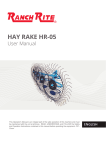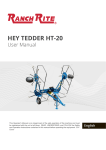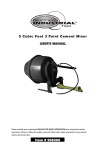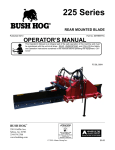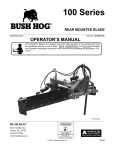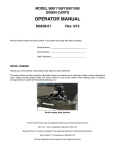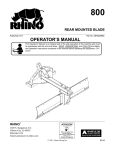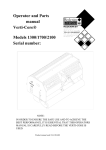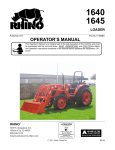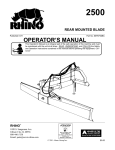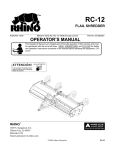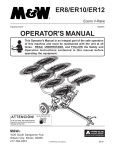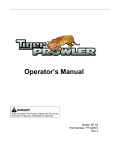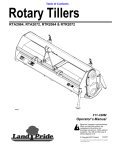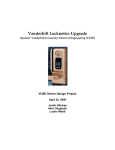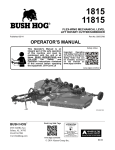Download operation
Transcript
HAY TEDDER HT-10 User Manual This Operator's Manual is an integral part of the safe operation of this machine and must be maintained with the unit at all times. READ, UNDERSTAND, and FOLLOW the Safety and Operation Instructions contained in this manual before operating the equipment. C01Cover ENGLISH TO THE OWNER/OPERATOR/DEALER All implements with moving parts are potentially hazardous. There is no substitute for a cautious, safe-minded operator who recognizes the potential hazards and follows reasonable safety practices. The manufacturer has designed this implement to be used with all its safety equipment properly attached to minimize the chance of accidents. BEFORE YOU START! Read the safety messages on the implement and shown in your manual. Observe the rules of safety and common sense! WARNING WARRANTY INFORMATION: Read and understand the complete Warranty Statement found in this Manual. Fill out the Warranty Registration Form in full and return it to within 30 Days. Make certain the Serial Number of the Machine is recorded on the Warranty Card and on the Warranty Form that you retain. TABLE OF CONTENTS 1 SAFETY SECTION ............................................................................................................... 1-1 General Safety Instructions and Practices .......................................................................................................... 1-2 Operator Safety Instructions and Practices ........................................................................................................ 1-3 Equipment Operation Safety Instructions and Practices..................................................................................... 1-5 Connecting or Disconnecting Implement Safety Instructions & Practices........................................................... 1-8 Transporting Safety Instructions and Practices .................................................................................................. 1-9 Maintenance and Service Safety Instructions and Practices ............................................................................ 1-11 Decal Location .................................................................................................................................................. 1-14 Decal Description .............................................................................................................................................. 1-15 Decal Description .............................................................................................................................................. 1-16 Federal Laws and Regulations ......................................................................................................................... 1-19 2 3 INTRODUCTION SECTION.................................................................................................. 2-1 ASSEMBLY SECTION ......................................................................................................... 3-1 GENERAL ASSEMBLY ...................................................................................................................................... 3-2 AXLE INSTALLATION ........................................................................................................................................ 3-2 TIRE & WHEEL ASSEMBLIES INSTALLATION ................................................................................................ 3-3 DRAWBAR & SHIELDS INSTALLATION ........................................................................................................... 3-3 TINE ASSEMBLIES INSTALLATION ................................................................................................................. 3-4 SAFETY GUARDS INSTALLATION ................................................................................................................... 3-4 4 OPERATION SECTION ........................................................................................................ 4-1 Standard Equipment and Specifications ............................................................................................................. 4-2 OPERATOR REQUIREMENTS .......................................................................................................................... 4-3 TRACTOR REQUIREMENTS............................................................................................................................. 4-4 ROPS and Seat Belt ........................................................................................................................................... 4-4 Tractor Horsepower ............................................................................................................................................ 4-4 Drawbar - Pull-Type Mower ................................................................................................................................ 4-5 Front End Weight ................................................................................................................................................ 4-5 GETTING ON AND OFF THE TRACTOR .......................................................................................................... 4-5 Boarding the Tractor ........................................................................................................................................... 4-5 Dismounting the Tractor...................................................................................................................................... 4-6 STARTING THE TRACTOR ............................................................................................................................... 4-7 CONNECTING THE HAY TEDDER TO THE TRACTOR ................................................................................... 4-7 Connecting the Hay Tedder ................................................................................................................................ 4-8 Safety Tow Chain................................................................................................................................................ 4-8 DRIVELINE ATTACHMENT ............................................................................................................................... 4-9 Driveline Length Check ....................................................................................................................................... 4-9 PRE-OPERATION INSPECTION AND SERVICE ............................................................................................ 4-11 Tractor Pre-Operation Inspection/Service......................................................................................................... 4-11 Hay Tedder Pre-Operation Inspection/Service ................................................................................................. 4-12 DRIVING THE TRACTOR AND IMPLEMENT .................................................................................................. 4-15 Starting the Tractor ........................................................................................................................................... 4-16 Brake and Differential Lock Setting................................................................................................................... 4-16 Driving the Tractor and Hay Tedder.................................................................................................................. 4-17 OPERATING THE TRACTOR AND IMPLEMENT............................................................................................4-17 Operating the Hay Tedder In Field (Manual Fold) ............................................................................................ 4-18 Adjustment For Correct Working Position ......................................................................................................... 4-18 PTO RPM and Ground Speed .......................................................................................................................... 4-19 Engaging the Power Take Off (PTO) ................................................................................................................ 4-19 Shutting Down the Implement ........................................................................................................................... 4-20 DISCONNECTING THE HAY TEDDER FROM THE TRACTOR ..................................................................... 4-20 HAY TEDDER STORAGE ................................................................................................................................ 4-21 TRANSPORTING THE TRACTOR AND IMPLEMENT .................................................................................... 4-22 Transport Instructions for Manual Fold ............................................................................................................. 4-22 Transporting on Public Roadways .................................................................................................................... 4-23 Hauling the Tractor and Implement................................................................................................................... 4-25 5 MAINTENANCE SECTION................................................................................................... 5-1 LUBRICATION .................................................................................................................................................... 5-2 ROTOR PHASING .............................................................................................................................................. 5-2 STORAGE .......................................................................................................................................................... 5-3 PROPER TORQUE FOR FASTENERS ............................................................................................................. 5-3 RANCH RITE 1830 W 15TH STREET HOUSTON, TEXAS 77008 SAFETY SECTION Safety Section 1-1 SAFETY General Safety Instructions and Practices A careful operator is the best operator. Safety is of primary importance to the manufacturer and should be to the owner/operator. Most accidents can be avoided by being aware of your equipment, your surroundings, and observing certain precautions. The first section of this manual includes a list of Safety Messages that, if followed, will help protect the operator and bystanders from injury or death. Read and understand these Safety Messages before assembling, operating or servicing this Implement. This equipment should only be operated by those persons who have read the manual, who are responsible and trained, and who know how to do so responsibly. The Safety Alert Symbol combined with a Signal Word, as seen below, is used throughout this manual and on decals which are attached to the equipment. The Safety Alert Symbol means: “ATTENTION! BECOME ALERT! YOUR SAFETY IS INVOLVED!” The Symbol and Signal Word are intended to warn the owner/operator of impending hazards and the degree of possible injury faced when operating this equipment. Practice all usual and customary safe working precautions and above all---remember safety is up to YOU. Only YOU can prevent serious injury or death from unsafe practices. DANGER Indicates an imminently hazardous situation that, if not avoided, WILL result in DEATH OR VERY SERIOUS INJURY. WARNING Indicates an imminently hazardous situation that, if not avoided, COULD result in DEATH OR SERIOUS INJURY. CAUTION Indicates an imminently hazardous situation that, if not avoided, MAY result in MINOR INJURY. IMPORTANT Identifies special instructions or procedures that, if not strictly observed, could result in damage to, or destruction of the machine, attachments or the environment. NOTE: Identifies points of particular interest for more efficient and convenient operation or repair.(SG-1) READ, UNDERSTAND, and FOLLOW the following Safety Messages. Serious injury or death may occur unless care is taken to follow the warnings and instructions stated in the Safety Messages. Always use good common sense to avoid hazards. (SG-2) PELIGRO Si no lee ingles, pida ayuda a alguien que si lo lea para que le traduzca las medidas de seguridad. (SG-3) HT-10 © 2014 Ranch Rite Safety Section 1-2 SAFETY WARNING Engine Exhaust, some of its constituents, and certain vehicle components contain or emit chemicals known to the state of California to cause cancer and birth defects or other reproductive harm. (SG-30) WARNING Battery posts, terminals and related accessories contain lead and lead compounds, chemicals known to the state of California to cause cancer, birth defects or other reproductive harm. (SG-31) WARNING Always maintain the safety signs in good readable condition. If the safety signs are missing, damaged, or unreadable, obtain and install replacement safety signs immediately. (SG-5) Operator Safety Instructions and Practices DANGER Never operate the Tractor or Implement until you have read and completely understand this Manual, the Tractor Operator’s Manual, and each of the Safety Messages found in the Manual or on the Tractor and Implement. Learn how to stop the tractor engine suddenly in an emergency. Never allow inexperienced or untrained personnel to operate the Tractor or Implement without supervision. Make sure the operator has fully read and understood the manuals prior to operation. (SG-4) WARNING The operator and all support personnel should wear hard hats, safety shoes, safety glasses, and proper hearing protection at all times for protection from injury including injury from items that may be thrown by the equipment. (SG-16) CAUTION PROLONGED EXPOSURE TO LOUD NOISE MAY CAUSE PERMANENT HEARING LOSS! Tractors with or without an Implement attached can often be noisy enough to cause permanent hearing loss. We recommend that you always wear hearing protection if the noise in the Operator’s position exceeds 80db. Noise over 85db over an extended period of time will cause severe hearing loss. Noise over 90db adjacent to the Operator over an extended period of time will cause permanent or total hearing loss. NOTE: Hearing loss from loud noise [from tractors, chain saws, radios, and other such sources close to the ear] is cumulative over a lifetime without hope of natural recovery. (SG-I7) HT-10 © 2014 Ranch Rite Safety Section 1-3 SAFETY WARNING Always read carefully and comply fully with the manufacturer’s instructions when handling oil, solvents, cleansers, and any other chemical agent. (SG-22) DANGER KEEP AWAY FROM ROTATING ELEMENTS to prevent entanglement and possible serious injury or death. (SG-24) DANGER Never allow children to play on or around Tractor or Implement. Children can slip or fall off the Equipment and be injured or killed. Children can cause the Implement to shift or fall crushing themselves or others. (SG-25) DANGER NEVER use drugs or alcohol immediately before or while operating the Tractor and Implement. Drugs and alcohol will affect an operator’s alertness and coordination and therefore affect the operator’s ability to operate the equipment safely. Before operating the Tractor or Implement, an operator on prescription or over-the-counter medication must consult a medical professional regarding any side effects of the medication that would hinder their ability to operate the Equipment safely. NEVER knowingly allow anyone to operate this equipment when their alertness or coordination is impaired. Serious injury or death to the operator or others could result if the operator is under the influence of drugs or alcohol. (SG-27) WARNING Prolonged operation may cause operator boredom and fatigue affecting safe operation. Take scheduled work breaks to help prevent these potentially impaired operating conditions. Never operate the Implement and Tractor in a fatigued or bored mental state which impairs proper and safe operation. (SG-32) WARNING Use extreme caution when getting onto the Implement to perform repairs, maintenance and when removing accumulated material. Only stand on solid flat surfaces to ensure good footing. Use a ladder or raised stand to access high spots which cannot be reached from ground level. Slipping and falling can cause serious injury or death. (SG-33) DANGER DO NOT operate this Implement on a Tractor that is not properly maintained. Should a mechanical or Tractor control failure occur while operating, immediately shut down the Tractor and perform repairs before resuming operation. Serious injury and possible death could occur from not maintaining this Implement and Tractor in good operating condition. (SG-36) HT-10 © 2014 Ranch Rite Safety Section 1-4 SAFETY WARNING Extreme caution should be used by the Tractor operator when operating near passersby. Stop raking if anyone comes within 25 feet of the Implement to prevent possible passerby injury or death from being struck from a thrown object, entanglement with the rakes, or run over. (SRK-01) Equipment Operation Safety Instructions and Practices WARNING Never leave the Tractor and Implement unattended while the Implement is in the lifted position. Accidental operation of lifting lever or a hydraulic failure may cause sudden drop of unit with injury or death by crushing. To properly park the implement when disconnecting it from the tractor, lower the stand and put the retaining pin securely in place, or put a secure support under the A-Frame. Lower the implement carefully to the ground. Do not put hands or feet under lifted components. (S3PT-1) CAUTION Do not back up with this implement. Backing could damage the machine or its components. WARNING Use extreme care when lowering or unfolding the implement’s wings. Make sure no bystanders are close by or underneath the wings. Allow ample clearance around the implement when folding or unfolding the wings. Use extreme caution around buildings or overhead power lines. (S3PT-05) DANGER There are obvious and hidden potential hazards in the operation of this Implement as in all power-driven or pulled equipment. REMEMBER! This machine is often operated in rough terrain conditions that include tall grass, weeds, gullies, holes, slopes, hidden obstructions and the like. Serious injury or even death may occur unless care is taken to assure the safety of the operator and bystanders in the area. Do not operate this machine with anyone in the immediate area. (S3PT-07) DANGER This Implement may be wider than the Tractor. Be careful when operating or transporting this equipment to prevent the Implement from running into or striking sign posts, guard rails, concrete abutments or other solid objects. Such an impact could cause the Implement and Tractor to pivot violently resulting in loss of steering control, serious injury, or even death. Never allow the Implement to contact obstacles. (S3PT-12) WARNING Operate this Implement only in conditions where you have clear visibility in daylight or with adequate artificial lighting. Never operate in darkness or foggy conditions where you cannot clearly see at least 100 yards in front and to the sides of the tractor and implement. Make sure that you can clearly see and identify passersby, steep slopes, ditches, drop-offs, overhead obstructions, power lines, debris and foreign objects. If you are unable to clearly see this type of items discontinue operating this equipment. (S3PT-21) (S3PT-4) HT-10 © 2014 Ranch Rite Safety Section 1-5 SAFETY WARNING Operate this Equipment only with a Tractor equipped with an approved rollover-protective system (ROPS). Always wear seat belts. Serious injury or even death could result from falling off the tractor--particularly during a turnover when the operator could be pinned under the ROPS. (SG-7) WARNING Do not modify or alter this Implement. Do not permit anyone to modify or alter this Implement, any of its components or any Implement function. (SG-8) DANGER BEFORE leaving the tractor seat, always set the parking brake and/or set the tractor transmission in parking gear, disengage the PTO, stop the engine, remove the key, and wait for all moving parts to stop. Place the tractor shift lever into a low range or parking gear to prevent the tractor from rolling. Never dismount a Tractor that is moving or while the engine is running. Operate the Tractor controls from the tractor seat only. (SG-9) DANGER Never allow children or other persons to ride on the Tractor or Implement. Falling off can result in serious injury or death. (SG-10) DANGER Never allow children to operate, ride on, or come close to the Tractor or Implement. Usually, 16-17 year-old children who are mature and responsible can operate the implement with adult supervision, if they have read and understand the Operator’s Manuals, been trained in proper operation of the tractor and Implement, and are physically large enough to reach and operate the controls easily. (SG-11) WARNING Do not mount or dismount the Tractor while the tractor is moving. Mount the Tractor only when the Tractor and all moving parts are completely stopped. (SG-12) DANGER Start tractor only when properly seated in the Tractor seat. Starting a tractor in gear can result in injury or death. Read the Tractor operators manual for proper starting instructions. (SG-13) HT-10 © 2014 Ranch Rite Safety Section 1-6 SAFETY WARNING Do not operate this Equipment with hydraulic oil or fuel leaking. Oil and fuel are explosive and their presence could present a hazard. Do not check for leaks with your hand! High-pressure oil streams from breaks in the line could penetrate the skin and cause tissue damage including gangrene. To check for a hose leak, SHUT the unit ENGINE OFF and remove all hydraulic pressure. Wear oil impenetrable gloves, safety glasses and use Cardboard to check for evidence of oil leaks. If you suspect a leak, REMOVE the HOSE and have it tested at a Dealer. If oil does penetrate the skin, have the injury treated immediately by a physician knowledgeable and skilled in this procedure. (SG-15) DANGER Never run the Tractor engine in a closed building or without adequate ventilation. The exhaust fumes can be hazardous to your health. (SG-23) WARNING Do not exceed the rated PTO speed for the Implement. Excessive PTO speeds can cause Implement driveline or blade failures resulting in serious injury or death. (SG-26) DANGER Operate the Tractor and/or Implement controls only while properly seated in the Tractor seat with the seat belt securely fastened around you. Inadvertent movement of the Tractor or Implement may cause serious injury or death. (SG-29) WARNING In case of mechanical difficulty during operation, place the transmission in the park position, set the parking brake, shut down all power, including the PTO and the engine and remove the key. Wait until all rotating motion has stopped before dismounting. (SG-39) WARNING Do Not operate this equipment in areas where insects such as bees may attack you and/or cause you to lose control of the equipment. If you must enter in such areas, use a tractor with an enclosed Cab and close the windows to prevent insects from entering. If a tractor cab is not available, wear suitable clothing including head, face, and hand protection to shield you from the insects. Attacking insects can cause you to lose control of the tractor, which can result in serious injury or death to you or bystanders. Never dismount a moving tractor. (SG-40) HT-10 © 2014 Ranch Rite Safety Section 1-7 SAFETY WARNING DANGER Objects such as wire, cable, rope, and chain can become entangled in the rotating parts of the raking components causing mechanical damage. Entangled items caught in the rakes can sling outward possibly injuring or entangling the operator or passersby. Any objects that might become entangled in a raking component should be removed from the area before operating the rake. (SRK-02) DO NOT allow any person under a folded wing unless wing is securely locked up or supported. DO NOT approach the Implement unless the Tractor is turned off and all motion has ceased. Never work under the frame work, or any lifted component unless the implement is securely supported or blocked up. A sudden or inadvertent fall by any of these components could cause serious injury or even death. (STI-03) Connecting or Disconnecting Implement Safety Instructions & Practices WARNING The rotating parts of this machine continue to rotate even after the PTO has been turned off. The operator should remain in his seat for 60 seconds after the brake has been set, the PTO disengaged, the tractor turned off, and all evidence of rotation has ceased. (S3PT-10) “Wait a minute...Save a life!” DANGER DO NOT use a PTO adapter to attach a non-matching Implement driveline to a Tractor PTO. Use of an adapter can double the operating speed of the Implement resulting in excessive vibration, thrown objects, and blade and implement failure. Adapter use will also change the working length of the driveline exposing unshielded driveline areas. Serious bodily injury and/or equipment failure can result from using a PTO adapter. Consult an authorized dealer for assistance if the Implement driveline does not match the Tractor PTO. (S3PT-14) DANGER Always shut the Tractor completely down, place the transmission in park, and set the parking brake before you or anyone else attempts to connect or disconnect the Implement and Tractor hitches. (S3PT-15) WARNING When attaching the Implement input driveline to the Tractor PTO, it is important that the connecting yoke spring activated locking collar slides freely and the locking balls are seated securely in the groove on the Tractor PTO shaft. Push and pull the driveline back and forth several times to ensure it is securely attached. A driveline not attached correctly to the Tractor PTO shaft could come loose and result in personal injury and damage to the Implement. (S3PT-17) HT-10 © 2014 Ranch Rite Safety Section 1-8 SAFETY WARNING Before operating the Implement, check to make sure the Implement input driveline will not bottom out or become disengaged. Bottoming out occurs when the inner shaft penetrates the outer housing until the assembly becomes solid-it can shorten no more. Bottoming out can cause serious damage to the Tractor PTO by pushing the PTO into the Tractor and through the support bearings or downward onto the PTO shaft, breaking it off. A broken driveline can cause personal injury. (S3PT-18) WARNING Never unhitch without using the Tongue Jack. The Tongue is very heavy. Attempting to lift the Tongue without using the Tongue Jack could cause strains or other injury. Allowing the tongue to fall suddenly and unexpectedly could result in crushing injury. Use the Tongue Jack for lifting the Implement only. Overloading the Tongue Jack can cause failure with possible serious bodily injury or even death. (STI-04) CAUTION On a fully-assembled unit, do not remove the Wing Retaining Strap until hoses are attached to the tractor and the Wing Cylinders are filled with oil. Lower the Wings slowly and carefully. Keep bystanders away during operations. (STI-05) Transporting Safety Instructions and Practices WARNING Be particularly careful when transporting the Implement with the Tractor. Turn curves or go up hills only at a low speed and using a gradual steering angle. Rear mounted implements move the center of gravity to the rear and remove weight from the front wheels. Make certain, by adding front ballast, that at least 20% of the tractor’s weight is on the front wheels to prevent rearing up, loss of steering control or Tractor tip-over. Slow down on rough or uneven surfaces to prevent loss of steering control which could result in property damage or possible injury. Do not transport unless 3-Point lift lever is fully raised and in the latched transport position. Dropping implement in transport can cause serious damage to the tractor and/or Implement and possibly cause the operator or others to be injured or killed. (S3PT-02) WARNING Allow sufficient clearance for the Implement to swing outward while turning. Implements carried behind the Tractor will swing outside the tire path when making turns. Contacting a solid object while turning will cause equipment damage and possible injury. (S3PT-20) WARNING Make certain that the “Slow Moving Vehicle” (SMV) sign is installed in such a way as to be clearly visible and legible. When transporting the Equipment use the Tractor flashing warning lights and follow all local traffic regulations. (SG-6) HT-10 © 2014 Ranch Rite Safety Section 1-9 SAFETY Transport only at speeds where you can maintain control of the equipment. Serious accidents and injuries can result from operating this equipment at high speeds. Understand the Tractor and Implement and how it handles before transporting on streets and highways. Make sure the Tractor steering and brakes are in good condition and operate properly. WARNING Before transporting the Tractor and Implement, determine the proper transport speeds for you and the equipment. Make sure you abide by the following rules: Test the tractor at a slow speed and increase the speed slowly. Apply the Brakes smoothly to determine the stopping characteristics of the Tractor and Implement. As you increase the speed of the Tractor the stopping distance increases. Determine the maximum transport speed not to exceed 20 mph (30 kph) for transporting this equipment. Test the equipment at a slow speed in turns. Increase the speed through the turn only after you determine that the equipment can be operated at a higher speed. Use extreme care and reduce your speed when turning sharply to prevent the tractor and implement from turning over. Determine the maximum turning speed for you and this equipment before operating on roads or uneven ground. Only transport the Tractor and Implement at the speeds which allow you to properly control the equipment. Be aware of the operating conditions. Do not operate the Tractor with weak or faulty brakes or worn tires. When operating down a hill or on wet or rain slick roads, the braking distance increases: use extreme care and reduce your speed. When operating in traffic always use the Tractor’s flashing warning lights and reduce your speed. Be aware of traffic around you and watch out for the other guy. (SG-19) DANGER Be particularly careful when transporting the Implement using the tractor. Turn curves or go up or down hills only at a low speed and at a gradual steering angle. Make certain that at least 20% of the tractor’s weight is on the front wheels to maintain safe steerage. Slow down on rough or uneven surfaces. (STI-01) When the Wings are folded for transport, the center of gravity is raised and the possibility of overturn is increased. Drive slowly and use extreme caution when turning on hillsides. Overturning the Implement could cause the Implement to overturn the Tractor and vice versa resulting in serious injury or even death. Never fold wings on a hillside...the DANGER Implement may overturn. WARNING (STI-02) Only tow the Implement behind a properly sized and equipped Tractor which exceeds the weight of the Implement by at least 20%. DO NOT tow the Implement behind a truck or other type of vehicle. Never tow the Implement and another Implement connected in tandem. Never tow the Implement at speeds over 20 MPH. (STI-06) HT-10 © 2014 Ranch Rite Safety Section 1-10 SAFETY Secure the Implement for transport before traveling on public roads. For pull-type Implements, secure the center axle using cylinder stops or transport pin and properly attach WARNING a safety chain between the Implement and Tractor. Secure wings in upright position on folding Implements using wing transport locks. (STI-7) Always keep a careful lookout and use extreme care when working around overhead obstructions and electrical power lines. The WARNING Implement wing can be over 10 feet high. Never allow the Implement wing to come within 10 feet of any power line. (STI-8) Your driving vision may be reduced or impaired by the tractor, cab, or implement. Before driving on public roadways identify any limited vision areas, and make adjustments to your operating position, mirrors, and the implement transport position so that you can clearly WARNING see the area where you will be traveling, and any traffic that may approach you. Failure to maintain adequate vision of the public roadway and traffic can result in serious injury or even death. (STI-10) Maintenance and Service Safety Instructions and Practices Make sure the PTO shield, integral driveline shields, and input shields are installed when using PTO-driven equipment. Always replace any shield if it is damaged or missing. (S3PT-8) DANGER Relieve hydraulic pressure prior to doing any maintenance or repair work on the Implement. Place the Implement on the ground or securely WARNING blocked up, disengage the PTO, and turn off the tractor engine. Push and pull the Remote Cylinder lever in and out several times prior to starting any maintenance or repair work. (S3PT-09) DANGER Always disconnect the main PTO Driveline from the Tractor before performing service on the Implement. Never work on the Implement with the tractor PTO driveline connected and running. Rotating Parts, Blades or Drivelines could turn without warning and cause immediate entanglement, injury or death. (S3PT-11) WARNING Keep fingers clear of adjusting holes. A sudden movement could cause injury or even amputate fingers. KEEP CHILDREN AWAY WHEN MAKING ADJUSTMENTS. (SBL-3) WARNING Always maintain the safety signs in good readable condition. If the safety signs are missing, damaged, or unreadable, obtain and install replacement safety signs immediately. (SG-5) HT-10 © 2014 Ranch Rite Safety Section 1-11 SAFETY WARNING DANGER Do not modify or alter this Implement. Do not permit anyone to modify or alter this Implement, any of its components or any Implement function. (SG-8) Never work under the Implement, the framework, or any lifted component unless the Implement is securely supported or blocked up to prevent sudden or inadvertent falling which could cause serious injury or even death. (SG-14) WARNING Never attempt to lubricate, adjust, or remove material from the Implement while it is in motion or while tractor engine is running. (SG-20) WARNING Periodically inspect all moving parts for wear and replace when necessary with authorized service parts. Look for loose fasteners, worn or broken parts, and leaky or loose fittings. Make sure all pins have cotter pins and washers. Serious injury may occur from not maintaining this machine in good working order. (SG-21) WARNING Perform service, repairs and lubrication according to the maintenance section. Ensure the unit is properly lubricated as specified in the lubrication schedule and all bolts and nuts are properly torqued. Failure to properly service, repair and maintain this Implement in good operating condition could cause component failure and possible serious injury or even death. (SG-35) WARNING Use caution and wear protective gloves when handling sharp objects such as blades, knives, and other cutting edges. Be alert to worn component surfaces which have sharp edges. Sharp surfaces can inflict severe laceration injuries if proper hand protection is not worn. (SG-37) HT-10 © 2014 Ranch Rite Safety Section 1-12 SAFETY PARTS INFORMATION Ranch Rite products are designed utilizing specifically matched system components to ensure optimum equipment performance. These parts are made and tested to Bush Hog specifications. Non-genuine "will fit" parts do not consistently meet these specifications. The use of “will fit” parts may reduce equipment performance, void warranties, and present a safety hazard. Use genuine Bush Hog parts for economy and safety. (SPBH-2) SEE YOUR RANCH RITE DEALER DANGER CAUTION A rear Implement can fall if not properly supported. Always use the stand on the front hitch (if equipped) or block up securely to prevent falling and possible crushing injury and/or other injury from holding or lifting heavy components. Use the stand to stabilize the implement during storage. (S3PT-3) To prevent tipping of Implement when stored in folded position, use carrying wheels or adequate stands on center frame. (S3PT-6) In addition to the design and configuration of this Implement, including Safety Signs and Safety Equipment, hazard control and accident prevention are dependent upon the awareness, concern, prudence, and proper training of personnel involved in the operation, transport, maintenance, and storage of the machine. Refer also to Safety Messages and operation instruction in each of the appropriate sections of the Tractor and Equipment Manuals. Pay close attention to the Safety Signs affixed to the Tractor and Equipment. (SG-18) HT-10 © 2014 Ranch Rite Safety Section 1-13 SAFETY Decal Location NOTE: Ranch Rite supplies safety decals on this product to promote safe operation. Damage to the decals may occur while in shipping, use, or reconditioning. Ranch Rite cares about the safety of its customers, operators, and bystanders, and will replace the safety decals on this product in the field, free of charge (Some shipping and handling charges may apply). Contact your Bush Hog dealer to order replacement decals. HT-10 © 2014 Ranch Rite Safety Section 1-14 SAFETY Decal Description ITEM PART NO. QTY LEVEL DESCRIPTION 1. 00725746 1 PELIGRO Spanish - Get Translation 2. 3678303 2 DANGER Rotors 3. 999001 1 WARNING Maintain Weight for Steerage 4. 999200 1 WARNING Multiple Hazard 5. 00763977 1 INSTRUCT Notice To Owner 6. 00786980 1 IMPORTANT Genuine Bush Hog Parts 7. 2738332 2 REFLECT Red Reflector 8. 2738333 2 REFLECT Yellow Reflector 9. 50063360 1 LOGO Ranch Rite 10. ________ 1 NAME HT-10 11. NFS 1 SER PLT Serial Plate 12. 03200347 1 REFLECT SMV 13. 00776031 1 ________ Canister, Operators Manual 14. 50068467C 1 ________ Operator’s Manual 15. 10058000 3 ________ Bolt 16. 00024100 3 ________ Flatwasher 17. 02959924 3 ________ Locknut HT-10 © 2014 Ranch Rite Safety Section 1-15 SAFETY Decal Description Peligro Translation, If you do not know how to read English, please find someone who knows how to read English. P/N 00725746 DANGER! Keep clear of rotors serious injury or death may result from entanglement. P/N 3678303 WARNING! Tractor rearing P/N 999001 WARNING!- Multiple Hazard and General Safety P/N 999200 HT-10 © 2014 Ranch Rite Safety Section 1-16 SAFETY Operator's Manual (with repair parts) and warranty was attached to this implement during final inspection. P/N 00763977 For safety and to guarantee optimum product reliability always use genuine Ranch Rite replacement parts. RUNCH RITE RUNCH RITE 1830 W 15th Street Houston, Texas 77008 P/N 00786980 Red Reflectors P/N 2738332 Yellow Reflectors P/N 2738333 HT-10 © 2014 Ranch Rite Safety Section 1-17 RUNCH RITE SAFETY Logo Product Name: Ranch Rite (8”) P/N 50063360 MODEL NAME - HT-10 HT-10 Name Slow Moving Vehicle Decal. Keep SMV reflector clean and visible. DO NOT transport or operate without the SMV. P/N 03200347 Read Operator’s Manual! The operator’s manual is located inside this canister. If the manual is missing order one from your dealer. P/N 00776031 HT-10 © 2014 Ranch Rite Safety Section 1-18 SAFETY Federal Laws and Regulations This section is intended to explain in broad terms the concept and effect of federal laws and regulations concerning employer and employee equipment operators. This section is not intended as a legal interpretation of the law and should not be considered as such. Employer-Employee Operator Regulations U.S. Public Law 91-596 (The Williams-Steiger Occupational and Health Act of 1970) OSHA This Act Seeks: “...to assure so far as possible every working man and woman in the nation safe and healthful working conditions and to preserve our human resources...” DUTIES Sec. 5 (a) Each employer(1) shall furnish to each of his employees employment and a place of employment which are free from recognized hazards that are causing or are likely to cause death or serious physical harm to his employees; (2) shall comply with occupational safety and health standards promulgated under this Act. (b) Each employee shall comply with occupational safety and health standards and all rules, regulations and orders issued pursuant to this Act which are applicable to his own actions and conduct. OSHA Training Requirements Title 29, Code of Federal Regulations Part 1928.57(a)(6). www.osha.gov Operator instructions. At the time of initial assignment and at least annually thereafter, the employer shall instruct every employee who operates an agricultural tractor and implements in the safe operating practices and servicing of equipment with which they are or will be involved, and of any other practices dictated by the work environment. Keep all guards in place when the machine is in operation; Permit no riders on equipment Stop engine, disconnect the power source, and wait for all machine movement to stop before servicing, adjusting, cleaning or unclogging the equipment, except where the machine must be running to be properly serviced or maintained, in which case the employer shall instruct employees as to all steps and procedures which are necessary to safely service or maintain the equipment. Make sure everyone is clear of machinery before starting the engine, engaging power, or operating the machine. Employer Responsibilities: To ensure employee safety during Tractor and Implement operation, it is the employer’s responsibility to: 1. 2. 3. 4. Train the employee in the proper and safe operation of the Tractor and Implement. Require that the employee read and fully understand the Tractor and Implement Operator’s manual. Permit only qualified and properly trained employees to operate the Tractor and Implement. Maintain the Tractor and Implement in a safe operational condition and maintain all shields and guards on the equipment. 5. Ensure the Tractor is equipped with a functional ROPS and seat belt and require that the employee operator securely fasten the safety belt and operate with the ROPS in the raised position at all times. 6. Forbid the employee operator to carry additional riders on the Tractor or Implement. 7. Provide the required tools to maintain the Tractor and Implement in a good safe working condition and provide the necessary support devices to secure the equipment safely while performing repairs and service. 8. Require that the employee operator stop operation if bystanders or passersby come within 25 feet. Child Labor Under 16 Years of Age Some regulations specify that no one under the age of 16 may operate power machinery. It is your responsibility to know what these regulations are in your own area or situation. (Refer to U.S. Dept. of Labor, Employment Standard Administration, Wage & Home Division, Child Labor Bulletin #102.) HT-10 © 2014 Ranch Rite Safety Section 1-19 INTRODUCTION SECTION Introduction Section 2-1 INTRODUCTION The HT-10 Hay Tedder is one of the fastest and most efficient hay tedders available. Rotor speed and forward drive speed should be selected for each individual job, since there are large variations in the nature and properties of different crops. This HT-10 Hay Tedder is designed with care and built with quality materials by skilled workers. Proper assembly, maintenance, and operating practices, as described in this manual, will help the owner/operator get years of satisfactory service from the machine. The purpose of this manual is to familiarize, instruct, and train. The Assembly Section instructs the owner/ operator in the correct assembly of the tedder using standard and optional equipment. Careful use and timely service saves extensive repairs and costly down time losses. The Operation and Maintenance sections of the manual trains the owner/operator how to work the tedder correctly and attend to appropriate maintenance. The front, rear, left, and right are determined by the normal direction of travel, the same as driving an automobile. HT-10 © 2014 Ranch Rite Introduction Section 2-2 INTRODUCTION Attention Owner/Operator BEFORE OPERATING THIS MACHINE: 1. Carefully read the Operator’s Manual, completely understand the Safety Messages and instructions, and know how to operate correctly both the tractor and implement. 2. Fill out the Warranty Card in full. Be sure to answer all questions, including the Serial Number of the Implement. Mail within 30 days of delivery date of this implement. NOTE: Warranties are honored only if completed “Owner Registration and Warranty” forms are received by Ranch Rite within thirty days of delivery of the implement. 3. Record the Implement Model and Serial Numbers on the Warranty page at the front of the Operator’s Manual. Keep this as part of the permanent maintenance file for the Implement HT-10 © 2014 Ranch Rite Introduction Section 2-3 ASSEMBLY SECTION Assembly Section 3-1 ASSEMBLY GENERAL ASSEMBLY Your new HT-10 Tedder is shipped partially assembled. Some assembly procedures described here may have been completed. Layout all components before starting and familiarize yourself with the parts by referring yourself to the parts breakdowns in this manual. Assembly is highly dangerous and must be carried out in strict accordance with the following instructions. We recommend that qualified personnel perform assembly. It is highly recommended that assembly be carried out in a flat, solid surface, open area with no people (particularly children) nearby who could be severely be injured if they were to touch or move any parts of the machine. When assembling the implement provide suitable lifting mechanisms and supports to stabilize the partially assembled implements. This will prevent them from falling and causing damage to the implement or serious injury. The steps for assembly are illustrated in the following pages. Depending on the experience of the assemblers and the tools available, it is not necessary that the instructions be followed in the exact order given here, but the safety precautions described above must always be followed carefully and scrupulously. CAUTION Make sure the area around the machine is clear before lowering the wings. Do not lower the tedder wings when people or pets are near the rotary tedder or folding mechanism. The tedder must be attached to the tractor when the wings are folded. WARNING Always use safety stands or blocking in conjunction with hydraulic jacks or joists. Do not rely on the jack or joist to carry the load. They could fail. AXLE INSTALLATION 1. Position the mainframe upside down as indicated in Asm-HT-0001. 2. Rotate the gearbox rotors (1 & 2) so that one disc's holes line up with the main axis of the frame (7) while the other disc's holes are spaced equal distance from the mainframe (5 & 6). 3. Remove the roll pin from the gearbox spindle and discard the spacer. Install axle on spindle as indicated on Asm-HT-0001, and fasten axle to spindle using large roll pin previously removed and second roll pin driven through the center of the larger roll pin. HT-10 © 2014 Ranch Rite Assembly Section 3-2 ASSEMBLY TIRE & WHEEL ASSEMBLIES INSTALLATION 1. Install large anti-wrap shield (1) on axle first. 2. Install Tire and Wheel Assembly next. 3. Install small dust cover (2) next and then fasten with washer (3) and nut (4). 4. Tighten nut to 45 Ft-Lbs. DRAWBAR & SHIELDS INSTALLATION 1. Lift unit and position upright. Supporting the unit with safety stands or blocking to prevent unit from falling. 2. Install drawbar on mainframe, aligning drawbar pivot holes (A) with mainframe lugs (B) and installing pivot pin (3) through both. 3. Retain pivot pin (3) with two cotter pins (6). 4. Insert pivot lug of angle adjustment handle (8) into pivot hole (9) on drawbar and retain with cotter pin (6). Attach fork end of angle adjustment handle (7) to lugs (D) on main frame using pin (4) and two cotter pins (6). 5. Attach PTO Shield (14) to main gearbox using 2 nuts (12). HT-10 © 2014 Ranch Rite Assembly Section 3-3 ASSEMBLY TINE ASSEMBLIES INSTALLATION Note: Two bundles of tines have been shipped with each HT-10. One bundle contains right hand tines and the other contains left hand tines. 1. Install the tines according to the diagram below using bolt (3) and nut (5), paying particular attention to the direction of rotation or the rotors and the orientation of the drawbar. SAFETY GUARDS INSTALLATION 1. Install right hand and left hand safety guards as shown in Figure 5, using two bolts (15) and two serrated washers (14). 2. Insert plugs (13) into ends of safety guards. HT-10 © 2014 Ranch Rite Assembly Section 3-4 OPERATION SECTION Operation Section 4-1 OPERATION Bush Hog HT-10 HAY TEDDER OPERATION INSTRUCTIONS Your Ranc Rite Hay Tedder should now be assembled and inspected for any evidence of defective or damaged parts before use. Any evidence of damage should be reported to your dealer immediately. This section of the Operator’s Manual is designed to familiarize, instruct, and educate safe and proper implement use to the operator. Pictures contained in this section are intended to be used as a visual aid to assist in explaining the operation of a Hay Tedder and are not necessarily of a HT-10. Some pictures may show shields removed for purposes of clarity. NEVER OPERATE this implement without all shields in place and in good operational condition. The operator must be familiar with the implement and tractor operation and all associated safety practices before operating the implement and tractor. Proper operation of the implement, as detailed in this manual, will help ensure years of safe and satisfactory use of the hay tedder. READ AND UNDERSTAND THE ENTIRE OPERATING INSTRUCTIONS AND SAFETY SECTION OF THIS MANUAL AND THE TRACTOR MANUAL BEFORE ATTEMPTING TO USE THE TRACTOR AND IMPLEMENT. If you do not understand any of the instructions, contact your nearest authorized dealer for a full explanation. Pay close attention to all safety signs and safety messages contained in this manual and those affixed to the implement and tractor. OPS-U- 0001 READ, UNDERSTAND, and FOLLOW the following Safety Messages. Serious injury or death may occur unless care is taken to follow the warnings and instructions stated in the Safety Messages. Always use good common sense to avoid hazards. (SG-2) 1. Standard Equipment and Specifications HT-10 Number of Rotors 2 Number of Arms 12 Number of Double Tines 12 Horsepower Requirements 15 Min. Working Width 10’ Transport Width (Approximate) 10’ Weight Approximate 385 lbs Tire Size 15.00 x 6300 - 6 Number of Tires 2 PTO 540 RPM, 1-3/8” Spline w/Slipclutch Folding Mechanism Spring Assist Working Speed 5 - MPH HT-10 © 2014 Ranch Rite Operation Section 4-2 OPERATION 2. OPERATOR REQUIREMENTS Safe operation of the unit is the responsibility of a qualified operator. A qualified operator has read and understands the implement and tractor Operator’s Manuals and is experienced in implement and tractor operation and all associated safety practices. In addition to the safety messages contained in this manual, safety signs are affixed to the implement and tractor. If any part of the operation and safe use of this equipment is not completely understood, consult an authorized dealer for a complete explanation. If the operator cannot read the manuals for themselves or does not completely understand the operation of the equipment, it is the responsibility of the supervisor to read and explain the manuals, safety practices, and operating instructions to the operator. Safe operation of equipment requires that the operator wear approved Personal Protective Equipment (PPE) for the job conditions when attaching, operating, servicing, and repairing the equipment. PPE is designed to provide operator protection and includes the following safety wear: PERSONAL PROTECTIVE EQUIPMENT (PPE) • • • • • • • Always Wear Safety Glasses Hard Hat Steel Toe Safety Footwear Gloves Hearing Protection Close Fitting Clothing Respirator or Filter Mask (depends operating conditions) OPS-U- 0002 DANGER on NEVER use drugs or alcohol immediately before or while operating the Tractor and Implement. Drugs and alcohol will affect an operator’s alertness and coordination and therefore affect the operator’s ability to operate the equipment safely. Before operating the Tractor or Implement, an operator on prescription or over-the-counter medication must consult a medical professional regarding any side effects of the medication that would hinder their ability to operate the Equipment safely. NEVER knowingly allow anyone to operate this equipment when their alertness or coordination is impaired. Serious injury or death to the operator or others could result if the operator is under the influence of drugs or alcohol. (SG-27) HT-10 © 2014 Ranch Rite Operation Section 4-3 OPERATION 3. TRACTOR REQUIREMENTS The tractor used to operate the tedder must have the power capacity to lift, pull, and operate the Power Take Off (PTO) at the tedder’s rated speed while traveling at a ground speed between 2 and 5 MPH. Operating the tedder with a tractor that does not meet the following requirements may cause tractor or tedder damage and be a potential danger to the operator and passersby. Tractor Requirements and Capabilities Tractor Requirements and Capabilities • • • ASABE approved Roll-Over Protective Structure (ROPS) or ROPS cab and seat belt. Tractor Safety Devices .................... Slow Moving Vehicle (SMV) emblem, lighting, PTO master shield Tractor Horsepower ......................... 15 HP Minimum 3.1 ROPS and Seat Belt The tractor must be equipped with a Roll-Over-Protective-Structure (ROPS) (tractor cab or roll-bar) and seat belt to protect the operator from falling off the tractor, especially during a roll over where the driver could be crushed and killed. Only operate the tractor with the ROPS in the raised position and seat belt fastened. Tractor model not equipped with a ROPS and seat belt should have these life saving features installed by an authorized dealer. OPS-U- 0003 WARNING Operate this Equipment only with a Tractor equipped with an approved rollover-protective system (ROPS). Always wear seat belts. Serious injury or even death could result from falling off the tractor--particularly during a turnover when the operator could be pinned under the ROPS. (SG-7) 3.2 Tractor Horsepower The power required to operate a implement is determined by the tractor PTO horsepower. For most operating conditions, the HT-10 requires a tractor with at least 15hp. Operating the implement with a tractor that does not have adequate power may damage the tractor engine. Exceeding the recommended horsepower may cause damage by overpowering the unit in heavy operating conditions. HT-10 © 2014 Ranch Rite Operation Section 4-4 OPERATION 3.3 Drawbar - Pull-Type Mower For pull-type mowers (540 and 1000 RPM) equipped with an equal-angle driveline, the tractor drawbar must be positioned at a 14” distance from the hitch point to the PTO shaft end for proper operation and minimal wear to the driveline and tractor. 3.4 Front End Weight A minimum of 20% total tractor weight must be maintained on the tractor front end at all times. Front end weight is critical to maintain steering control and to prevent the tractor from rearing up while driving. If the front end is too light, add weight until a minimum of 20% total weight is reached on the front tires. Front weights and weight carriers can be purchased through an authorized tractor dealership. OPS-U- 0005 4. GETTING ON AND OFF THE TRACTOR Before getting onto the tractor, the operator must read and completely understand the implement and tractor operator manuals. If any part of either manual is not completely understood, consult an authorized dealer for a complete explanation. OPS-U- 0007 WARNING Do not mount or dismount the Tractor while the tractor is moving. Mount the Tractor only when the Tractor and all moving parts are completely stopped. (SG-12) 4.1 Boarding the Tractor Use both hands and equipped handrails and steps for support when boarding the tractor. Never use control levers for support when mounting the tractor. Seat yourself in the operator’s seat and secure the seat belt around you. Never allow passengers to ride on the tractor or attached equipment. Riders can easily fall off and be seriously injured or killed from falling off and being ran over. It is the operator’s responsibility to forbid all extra riders at all times. OPS-U- 0008 HT-10 © 2014 Ranch Rite Operation Section 4-5 OPERATION DANGER Never allow children to operate, ride on, or come close to the Tractor or Implement. Usually, 16-17 year-old children who are mature and responsible can operate the implement with adult supervision, if they have read and understand the Operator’s Manuals, been trained in proper operation of the tractor and Implement, and are physically large enough to reach and operate the controls easily. (SG-11) DANGER Never allow children or other persons to ride on the Tractor or Implement. Falling off can result in serious injury or death. (SG-10) 4.2 Dismounting the Tractor Before dismounting, park the tractor and implement on a reasonably level surface, apply the parking brake, idle the engine down, disengage the PTO, and lower the implement to the ground. Shut down the tractor engine according to the operator’s manual, remove the key, and wait for all motion to completely stop. Never leave the seat until the tractor, its engine and all moving parts have come to a complete stop. Use hand rails and steps when exiting the tractor. Be careful of your step and use extra caution when mud, ice, snow or other matter has accumulated on the steps or hand rails. Use all handrails and steps for support and never rush or jump off the tractor. OPS-U- 0009 DANGER BEFORE leaving the tractor seat, always set the parking brake and/or set the tractor transmission in parking gear, disengage the PTO, stop the engine, remove the key, and wait for all moving parts to stop. Place the tractor shift lever into a low range or parking gear to prevent the tractor from rolling. Never dismount a Tractor that is moving or while the engine is running. Operate the Tractor controls from the tractor seat only. (SG-9) HT-10 © 2014 Ranch Rite Operation Section 4-6 OPERATION 5. STARTING THE TRACTOR The operator must have a complete understanding of the placement, function, and operational use of all tractor controls before starting the tractor. Review the tractor operator’s manual and consult an authorized dealer for tractor operation instructions if needed. Essential Tractor Controls: • Locate the light control lever. • Locate the engine shut off control. • Locate the brake pedals and the clutch. • Locate the PTO control. • Locate the 3-point hitch control lever. • Locate the hydraulic remote control levers. Before starting the tractor ensure the following: • Conduct all pre-start operation inspection and service according to the tractor operator’s manual. • Make sure all guards, shields, and other safety devices are securely in place. • The parking brake is on. • The PTO control lever is disengaged. • The 3-point hitch control lever is in the lowered position. • The hydraulic remote control levers are in the neutral position. • The tractor transmission levers are in park or neutral. Refer to the tractor owner’s manual for tractor starting procedures. Only start the tractor while seated and belted in the tractor operator’s seat. Never bypass the ignition switch by short circuiting the starter solenoid. After the tractor engine is running, avoid accidental contact with the tractor transmission to prevent sudden and unexpected tractor movement. OPS-U-0028 DANGER Never run the Tractor engine in a closed building or without adequate ventilation. The exhaust fumes can be hazardous to your health. (SG-23) DANGER Start tractor only when properly seated in the Tractor seat. Starting a tractor in gear can result in injury or death. Read the Tractor operators manual for proper starting instructions. (SG-13) 6. CONNECTING THE HAY TEDDER TO THE TRACTOR Use extreme caution when connecting the hay tedder to the tractor. The hay tedder should be securely resting at ground level or setting on blocks. Keep hands and feet from under the hay tedder and clear of pinch points between the tractor hitch arms and lift side rotors. OPS-HT-0011 HT-10 © 2014 Ranch Rite Operation Section 4-7 OPERATION DANGER Always shut the Tractor completely down, place the transmission in park, and set the parking brake before you or anyone else attempts to connect or disconnect the Implement and Tractor hitches. (S3PT-15) 6.1 Connecting the Hay Tedder The attachment of pull-type machines to the tractor is very simple, as it is only necessary to couple the drawbar hitch to the tractor hitch using a pin of appropriate size, strength and shape. Always use extreme care when reversing the tractor towards the machine. Once the implement is hitched to the tractor, the drawbar parking stand (6) must be raised from the parking position. To do this, remove clip (8) and pin (7), and rotate the parking stand so that it is paralleled with drawbar (1). Fasten into the new position using pin (7) and clip (8). Once this procedure is completed, insert the quick-release coupling into the tractor socket. 6.2 Safety Tow Chain If the mower is towed on a public roadway, a safety chain with tensile strength equal to or greater than the gross weight of the mower must be connected between the tractor and mower. This will help control the implement in the event the tongue becomes disconnected from the drawbar. Make sure the chain is attached to a secure location on the tractor and not to an intermediate support. After connecting both ends of the safety chain, drive the tractor to the right and left to check for proper chain length. Adjust length as necessary and allow only enough slack in the chain to make a maximum turn in both directions. When not in use, store the safety chain to protect it from mud or standing water by wrapping the chain around the tongue. Replace the safety chain if one or more links or end fittings are broken, stretched or otherwise damaged or deformed. OPS-U-0039 HT-10 © 2014 Ranch Rite Operation Section 4-8 OPERATION DANGER Never work under the Implement, the framework, or any lifted component unless the Implement is securely supported or blocked up to prevent sudden or inadvertent falling which could cause serious injury or even death. (SG-14) 7. DRIVELINE ATTACHMENT The driveline yoke and tractor PTO shaft must be dirt free and greased for attachment. To connect the tedder driveline to the tractor PTO output shaft, pull the driveline yoke collar back and align the grooves and splines of the yoke with those of the PTO shaft. Push the driveline yoke onto the PTO shaft, release the locking collar, and position the yoke until the locking collar balls are seated onto the PTO shaft. Push and pull the driveline back and forth several times to ensure a secure attachment. OPS-HT-0003 7.1 Driveline Length Check When fitting the hay tedder to the tractor, the driveline must be inspected to ensure that it is connected correctly both at the tractor end and at the implements end. If a safety system is provided, this should be fitted to the machine end, not to the tractor end. During both transport and use, avoid conditions where the Driveline transmission shaft is extended to the maximum. In all working conditions, the telescopic tubes must overlap by at least 1/3 of their length. Figure OP-224. HT-10 © 2014 Ranch Rite Operation Section 4-9 OPERATION Conversely, when the driveline shaft is contracted to the maximum, there should still be a gap of approximately 2” (50 mm). Figure OP-225 Take particular care when connecting the two Driveline shaft end forks and make sure that they are fully secured. This is achieved by inserting the safety pins and bolts (1) in the special slots (2) on the power takeoff shafts on both the tractor and implement ends. Figure OP-226. HT-10 © 2014 Ranch Rite Operation Section 4-10 OPERATION 8. PRE-OPERATION INSPECTION AND SERVICE Before each use, a pre-operation inspection and service of the implement and tractor must be performed. This includes routine maintenance and scheduled lubrication, inspecting that all safety devices are equipped and functional, and performing needed repairs. DO NOT operate the unit if the pre-operation inspection reveals any condition affecting safe operation. Perform repairs and replacement of damaged and missing parts as soon as noticed. By performing a thorough pre-operation inspection and service, valuable down time and repair cost can be avoided. OPS-U-0029 WARNING Periodically inspect all moving parts for wear and replace when necessary with authorized service parts. Look for loose fasteners, worn or broken parts, and leaky or loose fittings. Make sure all pins have cotter pins and washers. Serious injury may occur from not maintaining this machine in good working order. (SG-21) 8.1 Tractor Pre-Operation Inspection/Service Refer to the tractor operator’s manual to ensure a complete pre-operation inspection and scheduled service is performed according to the manufacturers recommendations. The following are some of the items that require daily service and inspection: • • • • • • • • • • • • • • • • • • Tire condition/air pressure Wheel lug bolts Steering linkage PTO shield SMV sign is clean and visible Tractor’s lights are clean and functional Tractor Seat belt is in good condition Tractor ROPS is in good condition ROPS is in the raised position No tractor oil leaks Radiator free of debris Engine oil level and condition Engine coolant level and condition Power brake fluid level Power steering fluid level Fuel condition and level Sufficient lubrication at all lube points Air filter condition OPS-U-0030 HT-10 © 2014 Ranch Rite Operation Section 4-11 OPERATION 8.2 Hay Tedder Pre-Operation Inspection/Service Before each use, a complete inspection and service is required to ensure the hay tedder is in a good and safe working condition. Damaged and/or broken parts should be repaired and/or replaced immediately. To ensure the hay tedder is ready for operation, conduct the following. OPS-HT-0020 The operator’s manual and safety signs affixed on the unit contain important instructions on the safe and proper use of the equipment. Maintain these important safety features on the implement in good condition to ensure the information is available to the operator at all times. • • Ensure the manual canister is secured to the equipment with the operator’s manual inside. Ensure all safety signs are in place and legible. Replace missing, damaged, and illegible decals. OPS-U- 0011 HT-10 © 2014 Ranch Rite Operation Section 4-12 OPERATION Hay Tedder PRE-OPERATION Inspection Mower ID#________________Make____________________ Date: WARNING ________________Shift____________________ Before conducting the inspection, make sure the tractor engine is off, all rotation has stopped and the tractor is in park with the parking brake engaged. Make sure the Tedder is resting on the ground or securely blocked up and all hydraulic pressure has been relieved. Item Condition at Start of Shift Specific Comments if not O.K. The Operator’s Manual is in the Canister on the Hay Tedder All Safety Decals are in place and legible The Tongue/Hitch connection bolts & pins are tight There are no cracks in Tongue or Hitch There are no cracks in Loader Arms or Mounts The Tow Chain is secured to the Tractor & Hay Tedder Driveline / Gearbox Shields are in good condition Driveline Clutches are in good condition, not frozen Driveline Telescoping Members & U-Joints are lubricated Driveline Yokes are securely attached to PTO & Tiller Gearbox Mounting Bolts are tight Gearbox Oil is at the proper level The Wing connection bolts & pins are tight Transport locks & retaining chains are in good condition Rake spokes are in good condition & securely attached Rake Wheels are securely attached to the frame members The Hydraulic Cylinders are in good condition The Hydraulic Cylinder pins are in place & retained There are no leaking or damaged hoses There is no evidence of hydraulic leaks The tires & wheel(s) are in good condition Wheel lug nuts are tight Operator’s Signature: DO NOT OPERATE an UNSAFE TRACTOR or TEDDER HT-10 © 2014 Ranch Rite Operation Section 4-13 OPERATION Tractor PRE-OPERATION Inspection Tractor ID#:___________ _____________Make:________________________ Date:______________________________Shift:________________________ WARNING Before conducting the inspection, make sure the tractor engine is off, all rotation has stopped and the tractor is in park with the parking brake engaged. Make sure the implement is resting on the ground or securely blocked up and all hydraulic pressure has been relieved. Condition at Start of Shift Item Specific Comments if not O.K. The flashing lights function properly The SMV Sign is clean and visible The tires are in good condition with proper pressure The wheel lug bolts are tight The tractor brakes are in good condition The steering linkage is in good condition There are no visible oil leaks The hydraulic controls function properly The ROPS or ROBS Cab is in good condition The seatbelt is in place and in good condition The 3-point hitch is in good condition The drawbar pins are securely in place The PTO master shield is in place The engine oil level is full The brake fluid level is full The power steering fluid level is full The fuel level is adequate The engine coolant fluid level is full The radiator is free of debris The air filter is in good condition Operator’s Signa ture:___________________________________________________ DO NOT OPERATE an UNSAFE TRACTOR or IMPLEMENT HT-10 © 2014 Ranch Rite Operation Section 4-14 OPERATION 9. DRIVING THE TRACTOR AND IMPLEMENT Safe tractor transport requires the operator possess a thorough knowledge of the model being operated and precautions to take while driving with an attached implement. Ensure the tractor has the capacity to handle the weight of the implement and the tractor operating controls are set for safe transport. To ensure safety while driving the tractor with an attached implement, review the following. OPS-U- 0012 DANGER This Implement may be wider than the Tractor. Be careful when operating or transporting this equipment to prevent the Implement from running into or striking sign posts, guard rails, concrete abutments or other solid objects. Such an impact could cause the Implement and Tractor to pivot violently resulting in loss of steering control, serious injury, or even death. Never allow the Implement to contact obstacles. (S3PT-12) Transport only at speeds where you can maintain control of the equipment. Serious accidents and injuries can result from operating this WARNING equipment at high speeds. Understand the Tractor and Implement and how it handles before transporting on streets and highways. Make sure the Tractor steering and brakes are in good condition and operate properly. Before transporting the Tractor and Implement, determine the proper transport speeds for you and the equipment. Make sure you abide by the following rules: Test the tractor at a slow speed and increase the speed slowly. Apply the Brakes smoothly to determine the stopping characteristics of the Tractor and Implement. As you increase the speed of the Tractor the stopping distance increases. Determine the maximum transport speed not to exceed 20 mph (30 kph) for transporting this equipment. Test the equipment at a slow speed in turns. Increase the speed through the turn only after you determine that the equipment can be operated at a higher speed. Use extreme care and reduce your speed when turning sharply to prevent the tractor and implement from turning over. Determine the maximum turning speed for you and this equipment before operating on roads or uneven ground. Only transport the Tractor and Implement at the speeds which allow you to properly control the equipment. Be aware of the operating conditions. Do not operate the Tractor with weak or faulty brakes or worn tires. When operating down a hill or on wet or rain slick roads, the braking distance increases: use extreme care and reduce your speed. When operating in traffic always use the Tractor’s flashing warning lights and reduce your speed. Be aware of traffic around you and watch out for the other guy. (SG-19) HT-10 © 2014 Ranch Rite Operation Section 4-15 OPERATION 9.1 Starting the Tractor The procedure to start the tractor is model specific. Refer to the tractor operator’s manual for starting procedures for your particular tractor. Consult an authorized dealer if the starting procedure is unclear. Ensure the 3-point control lever is in the lowered position and the PTO is disengaged before starting the tractor. OPS-U-0033 9.2 Brake and Differential Lock Setting Make sure the tractor brakes are in good operating condition. Tractor brakes can be set to operate independently allowing single rear wheel braking action or locked together to provide simultaneous rear wheel braking. FOR MOST DRIVING AND OPERATING CONDITIONS, THE BRAKE PEDALS SHOULD BE LOCKED TOGETHER TO PROVIDE THE MOST EFFECTIVE BRAKING ACTION. Always disengage the tractor differential lock when turning. When engaged the differential lock will prevent or limit the tractor from turning. During normal cutting conditions, locking the differential provides no benefit and should not be used. OPSU- 0013 Be aware of the operating conditions. Do not operate the Tractor with weak or faulty brakes. When operating down a hill or on wet or rain slick roads, the braking distance increases; use WARNING extreme care and reduce your speed in these conditions. When operating in traffic, always use the Tractor’s flashing warning lights and reduce your speed. Be aware of traffic around you and watch out for the other guy. HT-10 © 2014 Ranch Rite Operation Section 4-16 OPERATION 9.3 Driving the Tractor and Hay Tedder Start off driving at a slow speed and gradually increase your speed while maintaining complete control of the tractor and implement. Moving slowly at first will also prevent the tractor from rearing up and loss of steering control. The tractor should never be operated at speeds that cannot be safely handled or which will prevent the operator from stopping quickly during an emergency. If the power steering or engine ceases operating, stop the tractor immediately as the tractor will be difficult to control. Perform turns with the tractor and implment at slow speeds to determine how the tractor with an attached implement handles a turn. Determine the safe speed to maintain proper control of the tractor when making turns. When turning with a towed implement, the overall working length of the unit is increased. Allow additional clearance for the implement when turning. To avoid overturns, drive the tractor with care and at safe speeds, especially when operating over rough ground, crossing ditches or slopes, and turning corners. Tractor wheel tread spacing should be increased when working on inclines or rough ground to reduce the possibility of tipping. Use extreme caution when operating on steep slopes. Keep the tractor in a low gear when going downhill. DO NOT coast or free-wheel downhill. OPS-HT-0037_A 10. OPERATING THE TRACTOR AND IMPLEMENT THE OPERATOR MUST COMPLETELY UNDERSTAND HOW TO OPERATE THE TRACTOR AND IMPLEMENT AND ALL CONTROLS BEFORE ATTEMPTING TO OPERATE. The operator must read and understand the Safety and Operation Sections of the implement and tractor operator’s manuals. These manuals must be read and explained to any operator who cannot read. Never allow someone to operate the implement and tractor without complete operating instructions. Before starting any operation, the operator must become familiar with the area to be worked in and any obstacles and hazards contained within to ensure safety to the operator, bystanders, and equipment. Special attention should be paid to foreign debris, rough terrain, steep slopes, and passersby and animals in the area. OPS-U- 0015 HT-10 © 2014 Ranch Rite Operation Section 4-17 OPERATION Operating the Hay Tedder In Field (Manual Fold) For the HT210 manual fold, lateral arms 1 & 2 should be lowered before hand. To do this, rotate pin 4 so that spring pins 3 on it, slides over tab “C”, causing pin 4 to exit from the hole in the inside pipe of the strut assembly (RH and LH side). Now lower lateral arms 1-2 by pulling on guards “A-B”. OPS-HT-0046_C 11. Adjustment For Correct Working Position These machines are very easily adjusted. For best operation, the tines 1 on the front side of the machine should brush the ground. To obtain this, turn the adjustment crank 2. HT-10 © 2014 Ranch Rite Operation Section 4-18 OPERATION 11.1 PTO RPM and Ground Speed Ground speed will depend upon the height, type, and density of vegetation. Recommended speed for efficient performance is 5 mph. Operate the implement at its 350-450 PTO RPM (540 MAX) rated speed to maintain good operation. Refer to the tractor operator’s manual or the tractor instrument panel for the engine speed and gear to provide the required PTO and desired ground speed. Make sure that the implement is operating at its full rated speed before entering into use. If it becomes necessary to temporarily regulate engine speed, increase or decrease the throttle gradually. Ground speed is achieved by transmission gear selection and not by the engine operating speed. The operator may be required to experiment with several gear range combinations to determine the best gear and range which provides the most ideal performance from the implement and most efficient tractor operation. As the severity of conditions increase, the ground speed should be decreased by selecting a lower gear to maintain the proper operating PTO speed. OPS-HT-0025 11.2 Engaging the Power Take Off (PTO) Before engaging the PTO, make certain that the area is clear of bystanders and passersby. The implement must be completely lowered and the deck positioned at a safe operating height. NEVER engage the PTO with the implement in the raised position. Set the tractor engine speed at approximately 1,000 RPM before engaging the PTO. Shift the PTO control to the on position, and slowly increase the engine speed until the PTO is operating at 350-450 RPM (540 MAX). If you hear unusual noises or see or feel abnormal vibrations, disengage the PTO immediately. Inspect the implement to determine the cause of the noise or vibration and repair the abnormality. OPS-HT- 0017 HT-10 © 2014 Ranch Rite Operation Section 4-19 OPERATION 11.3 Shutting Down the Implement To shut down the implement, first bring the tractor to a complete stop. Then slow down the implement by reducing the engine speed before disengaging the PTO. Wait for all motion to stop before proceeding to drive or shut down the tractor. Park the tractor on a level surface, place the transmission in park or neutral and apply the parking brake, lower the attached implement to the ground, shut down the engine, remove the key, and wait for all motion to come to a complete stop before exiting the tractor. OPS-HT- 0016_A 12. DISCONNECTING THE HAY TEDDER FROM THE TRACTOR Before disconnecting the hay tedder, the PTO must be disengaged and all movement must cease. Move the hay tedder to a level storage location and lower the unit to the ground. If the hay tedder is not resting securely on the ground, block the hay tedder up securely before attempting to disconnect it from the tractor. Use extreme care to keep feet and hands from under the hay tedder and clear of any pinch points. OPS-HT0051 DANGER Always shut the Tractor completely down, place the transmission in park, and set the parking brake before you or anyone else attempts to connect or disconnect the Implement and Tractor hitches. (S3PT-15) HT-10 © 2014 Ranch Rite Operation Section 4-20 OPERATION Before disconnecting the machine from the tractor, use the hydraulic lever to unfold and lower the machine completely, apply the brake and shut off the tractor. Relieve hydraulic pressure by moving the control levers back and forth several times. Dismount from the tractor and place the parking stand in the vertical position. Turn the crank to raise the machine from the drawbar so that the hitch pin may be removed from the tractor. Disconnect the quick-release coupling. Disconnect the driveline and rest on the driveline holder. The tractor can now be moved away. OPS-HT-0052 13. HAY TEDDER STORAGE Properly preparing and storing the hay tedder at the end of the season is critical to maintaining its appearance and to help ensure years of dependable service. The following are suggested storage procedures: • Thoroughly clean all debris off the implement to prevent damage from decaying grass. • Lubricate all grease points and fill gearbox oil levels as detailed in the maintenance section. • Tighten all bolts and pins to the recommended torque. • Check worn and damaged parts. Perform repairs and make replacements immediately so that the implement will be ready for use at the start of the next season. • Store the hay tedder in a clean, dry place with the housing resting securely on blocks or at ground level. • Use spray touch-up enamel where necessary to prevent rust and maintain the appearance of the hay tedder. Store tedder with the wings lowered and the main transport wheels lowered. OPS-HT-0053 DANGER Never allow children to play on or around Tractor or Implement. Children can slip or fall off the Equipment and be injured or killed. Children can cause the Implement to shift or fall crushing themselves or others. (SG-25) HT-10 © 2014 Ranch Rite Operation Section 4-21 OPERATION 14. TRANSPORTING THE TRACTOR AND IMPLEMENT Inherent hazards of operating the tractor and implement and the possibility of accidents are not left behind when you finish working in an area. Therefore, the operator must employ good judgement and safe operation practices when transporting the tractor and implement between locations. By using good judgement and following safe transport procedures, the possibility of accidents while moving between locations can be substantially minimized. OPS-U- 0017 DANGER Never allow children or other persons to ride on the Tractor or Implement. Falling off can result in serious injury or death. (SG-10) 14.1 Transport Instructions for Manual Fold Before transporting the implement, it is necessary raise lateral arms 1 & 2. To do this, first check that spring pin 4, is not touching tab C (RH and LH side). Then raise lateral arms 1 & 2 by pulling on guards A-B until pin 4 of the spring strut assembly enters hole D (RH and LH side) of the inside pipe of the strut assembly. OPS-HT- 0055_A HT-10 © 2014 Ranch Rite Operation Section 4-22 OPERATION Before transporting the tractor on a public roadway or boarding a trailer for transport, the tractor brake pedals should be locked together. Locking the pedals ensures that both wheels brake simultaneously while stopping, especially when making an emergency stop. Use extreme caution and avoid hard applications of the tractor brakes when towing heavy loads at road speeds. Never tow the implement at speeds greater than 20 MPH (25 kph). OPS-U- 0018 14.2 Transporting on Public Roadways Extreme caution should be used when transporting the tractor and implement on public roadways. The tractor must be equipped with all required safety warning features including a SMV emblem and flashing warning lights to alert drivers of the tractor’s presence. Remember that roadways are primarily designed for automotive drivers and most drivers will not be looking out for you, therefore, you must look out for them. Check your side view mirrors frequently and remember that vehicles will approach quickly because of the tractor’s slower speed. Be extremely cautious when the piece of equipment that you are towing is wider than the tractor tire width and/or extends beyond your lane of the road. Make sure that a proper size safety tow chain is secured between the tractor and implement before entering a public road. OPS-U- 0019 WARNING Only tow the Implement behind a properly sized and equipped Tractor which exceeds the weight of the Implement by at least 20%. DO NOT tow the Implement behind a truck or other type of vehicle. Never tow the Implement and another Implement connected in tandem. Never tow the Implement at speeds over 20 MPH. (STI-06) DANGER Never allow children or other persons to ride on the Tractor or Implement. Falling off can result in serious injury or death. (SG-10) WARNING Make certain that the “Slow Moving Vehicle” (SMV) sign is installed in such a way as to be clearly visible and legible. When transporting the Equipment use the Tractor flashing warning lights and follow all local traffic regulations. (SG-6) HT-10 © 2014 Ranch Rite Operation Section 4-23 OPERATION The SMV (Slow-Moving Vehicle) emblem is universal symbol used to alert drivers of the presence of equipment traveling on roadways at a slow speed. SMV signs are a triangular bright orange with reflective red trim for both easy day and night visibility. Make sure the SMV sign is clean and visible from the rear of the unit before transporting the tractor and implement on a public roadway. Replace the SMV emblem if faded, damaged, or no longer reflective. OPS-U- 0020 Make sure that all tractor flashing warning lights, headlights, and brake/tail lights are functioning properly before proceeding onto public roads. While newer model tractors have plenty of lighting to provide warning signals and operating lighting, most older models are only equipped with operating lights. Consult an authorized tractor dealer for lighting kits and modifications available to upgrade the lighting on older tractor models. OPS-U- 0021 When operating on public roads, have consideration for other road users. Pull to the side of the road occasionally to allow all following traffic to pass. Do not exceed the legal speed limit set in your country for agricultural tractors. Always stay alert when transporting the tractor and implement on public roads. Use caution and reduce speed if other vehicles or pedestrians are in the area. OPSU- 0022 HT-10 © 2014 Ranch Rite Operation Section 4-24 OPERATION Reduce speed before turning or applying the brakes. Ensure that both brake pedals are locked together when operating on public roads. OPS-U- 0023 14.3 Hauling the Tractor and Implement Before transporting a loaded tractor and implement, measure the height and width dimensions and gross weight of the complete loaded unit. Ensure that the load will be in compliance with the legal limits set for the areas that will be traveled through. OPS-U- 0024 Use adequately sized and rated trailers and equipment to transport the tractor and implement. Consult an authorized dealer to determine the proper equipment required. Using adequately sized chains, heavy duty straps, cables and/or binders, securely tie down both the front and rear of the tractor utilizing the proper tie down locations as specified by the tractor manufacturer. OPS-U- 0025 HT-10 © 2014 Ranch Rite Operation Section 4-25 MAINTENANCE SECTION Maintenance Section 5-1 © 2014 Ranch Rite MAINTENANCE Although very little can go wrong with the machine in normal working conditions, a regular inspection of moving parts is advisable to obtain a full working life. LUBRICATION 1. Lubricate the IID shaft after every 5 hours of use. 2. Lubricate all grease fitting locations on the center section, rotating parts and any other parts after every 10 hours of use. 3. Check the grease level in the gearbox each working day. Use Multi-Purpose Gear Oil 00786250 when necessary. Fill to level plug. 4. After every 10 hours of operation, check all bolts, nuts, and tines. Tighten as needed. IMPORTANT The Center Main Gearbox should be lubricated after 50 working hours. Use Multi-Purpose Gear Oil P/N 00786250. How to Lubricate (Mnt-HT-0001): 1. Remove plugs (1 & 2). 2. Inject grease into hole (A) by using nipple (3) fitted to a pump, until grease comes out of upper hole (B). 3. A complete lubrication requires 2 lbs. of grease. 4. After lubrication you should retighten plugs (1 & 2). ROTOR PHASING Whenever maintenance is required on the gearboxes, the rotor phasing must be checked before operation to keep the arms from interfering in operation. The correct rotor phasing is shown below (Mnt-HT-0002).t. HT-10 © 2014 Ranch Rite Maintenance Section 5-2 MAINTENANCE STORAGE Lower the tongue stand and disconnect the tender from the tractor. Do not disconnect the tedder from the tractor before blocking wheels and securing stand. CAUTION Before disconnecting the tedder from the drawbar, crank the lifting screw to adjust the tines to the working position. This will move the center of gravity forward so more of the weight of the machine is on the tongue stand and prevent the tedder from tilting backwards. PROPER TORQUE FOR FASTENERS The chart lists the correct tightening torque for fasteners. When bolts are to be tightened or replaced, refer to this chart to determine the grade of bolts and the proper torque except when specific torque values are assigned in manual text. RECOMMENDED TORQUE IN FOOT POUNDS UNLESS OTHERWISE STATED IN THE MANUAL* NOTE: These values apply to fasteners as received from supplier, dry or when lubricated with normal engine oil. They do not apply if special graphited or molydisulphide greases or other extreme pressure lubricants are used. This applies to both UNF fine and UNC coarse threads. Proper Torque Values for Standard Bolts Bolt Diameter Head Marking Three Lines Grade Five Head Marking Six Lines Grade Eight Pound - Foot Value Dry Pound - Foot Value Dry Proper Torque Values for Metric Bolts Bolt Diameter 4.6 8.8 10.9 12.9 Head Marking 4.6 Head Marking 8.8 or 9.8 Head Marking 10.9 Head Marking 12.9 Pound - Foot Value Dry Pound - Foot Value Dry Pound - Foot Value Dry Pound - Foot Value Dry 1/4’’ 7 10 6mm 3 7 9 10 5/16’’ 15 22 8mm 6.2 16 23 24 3/8’’ 26 39 10mm 12 32 45 47 7/16’’ 1/2’’ 42 64 100 60 88 134 12mm 14mm 16mm 21 34 53 55 88 137 79 126 196 81 130 202 9/16’’ 5/8’’ 128 180 18mm 73 189 270 279 3/4’’ 7/8’’ 227 365 320 315 20mm 22mm 104 141 267 364 384 529 394 537 1’’ 547 772 24mm 27mm 179 262 461 676 660 968 680 998 30mm 355 917 1312 1353 To get Newton-Meters multiply pound-foot of torque by 1.356 HT-10 © 2014 Ranch Rite Maintenance Section 5-3 LIMITED WARRANTY Ranch Rite warrants to the original purchaser of any new Ranch Rite equipment, purchased from an authorized dealer, that the equipment be free from defects in material and workmanship for a period of one (1) year for non-commercial, state and municipalities’ use and ninety (90) days for commercial use from date of retail sale. The obligation of Ranch Rite to the purchaser under this warranty is limited to the repair or replacement of defective parts. Replacement or repair parts installed in the equipment covered by this limited warranty are warranted for ninety (90) days from the date of purchase of such part or to the expiration of the applicable new equipment warranty period, whichever occurs later. Warranted parts shall be provided at no cost to the user at an authorized Ranch Rite dealer during regular working hours. Ranch Rite reserves the right to inspect any equipment or parts which are claimed to have been defective in material or workmanship. DISCLAIMER OF IMPLIED WARRANTIES & CONSEQUENTIAL DAMAGES Ranch Rite’s obligation under this limited warranty, to the extent allowed by law, is in lieu of all warranties, implied or expressed, INCLUDING IMPLIED WARRANTIES OF MERCHANTABILITY AND FITNESS FOR A PARTICULAR PURPOSE and any liability for incidental and consequential damages with respect to the sale or use of the items warranted. Such incidental and consequential damages shall include but not be limited to: transportation charges other than normal freight charges; cost of installation other than cost approved by Ranch Rite; duty; taxes; charges for normal service or adjustment; loss of crops or any other loss of income; rental of substitute equipment, expenses due to loss, damage, detention or delay in the delivery of equipment or parts resulting from acts beyond the control of Ranch Rite. THIS LIMITED WARRANTY SHALL NOT APPLY: 1. To vendor items which carry their own warranties, such as engines, tires, and tubes. 2. If the unit has been subjected to misapplication, abuse, misuse, negligence, fire or other accident. 3. If parts not made or supplied by Ranch Rite have been used in connection with the unit, if, in the sole judgement of Ranch Rite such use affects its performance, stability or reliability. 4. If the unit has been altered or repaired outside of an authorized Ranch Rite dealership in a manner which, in the sole judgement of Ranch Rite, affects its performance, stability or reliability. 5. To normal maintenance service and normal replacement items such as gearbox lubricant, hydraulic fluid, worn blades, or to normal deterioration of such things as belts and exterior finish due to use or exposure. 6. To expendable or wear items such as teeth, chains, sprockets, belts, springs and any other items that in the company’s sole judgement is a wear item. NO EMPLOYEE OR REPRESENTATIVE OF RANCH RITE IS AUTHORIZED TO CHANGE THIS LIMITED WARRANTY IN ANY WAY OR GRANT ANY OTHER WARRANTY UNLESS SUCH CHANGE IS MADE IN WRITING AND SIGNED BY RANCH RITE’S SERVICE MANAGER, 1830 W 15TH STREET HOUSTON, TEXAS 77008 Record the model number, serial number and date purchased. This information will be helpful to your MODEL NUMBER ________________________________ dealer if parts or service are required. SERIAL NUMBER ________________________________ MAKE CERTAIN THE WARRANTY HAS BEEN FILED WITH RANCH RITE HOUSTON, TEXAS DATE OF RETAIL SALE ___________________________ TO THE OWNER/OPERATOR/DEALER To keep your implement running efficiently and safely, read your manual thoroughly and follow these directions and the Safety Messages in this Manual. The Table of Contents clearly identifies each section where you can easily find the information you need. The OCCUPATIONAL SAFETY AND HEALTH ACT (1928.51 Subpart C) makes these minimum safety requirements of tractor operators: REQUIRED OF THE OWNER: 1. Provide a Roll-Over-Protective Structure that meets the requirements of this Standard; and 2. Provide Seat belts that meet the requirements of this paragraph of this Standard and SAE J4C; and 3. Ensure that each employee uses such Seat belt while the tractor is moving; and 4. Ensure that each employee tightens the Seat belt sufficiently to confine the employee to the protected area provided by the ROPS REQUIRED OF THE OPERATOR: 1. Securely fasten seat belt if the tractor has a ROPS. 2. Where possible, avoid operating the tractor near ditches, embankments, and holes. 3. Reduce speed when turning, crossing slopes, and on rough, slick, or muddy surfaces. 4. Stay off slopes too steep for safe operation. 5. Watch where you are going - especially at row ends, on roads, and around trees. 6. Do not permit others to ride. 7. Operate the tractor smoothly - no jerky turns, starts, or stops. 8. Hitch only to the drawbar and hitch points recommended by the tractor manufacturer. 9. When the tractor is stopped, set brakes securely and use park lock, if available. x Keep children away from danger all day, every day... x Equip tractors with rollover protection (ROPS) and keep all machinery guards in place... x Please work, drive, play and live each day with care and concern for your safety and that of your family and fellow citizens. 1830 W 15th Street Houston, Texas 77008 HT-10 © 2014 Ranch Rite Printed U.S.A HAY TEDDER P/N 50068746C
































































